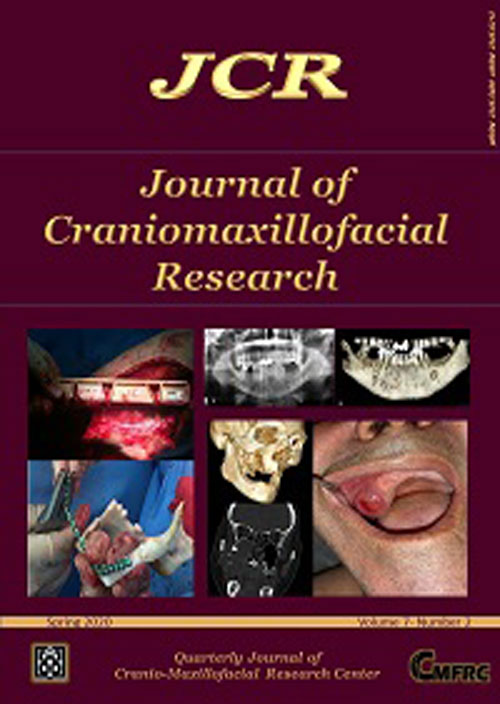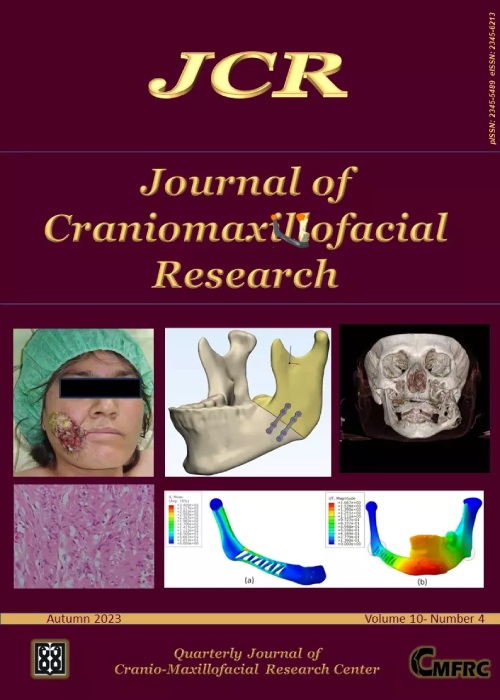فهرست مطالب

Journal of Craniomaxillofacial Research
Volume:7 Issue: 2, Spring 2020
- تاریخ انتشار: 1399/08/24
- تعداد عناوین: 8
-
-
Pages 50-61Introduction
Sleep apnea is a disorder in which the person’s breathing is interrupted periodically at night due to the physical blockage of the airway. Determining the best way to treat their sleep disorders requires careful studies, tests, counseling and various examinations. Orthodontics is the best way to get a patient to have oral equipment. The use of orthodontic equipment is a non-surgical and effective treatment for mild to moderate sleep apnea. The aim at this study is a systematic review and meta-analysis of orthodontics as a therapeutic tool for managing sleep apnea.
Materials and MethodsAt first, all the papers (n=112) related to keywords (orthodontics therapeutic tools and sleep apnea) were searched for English databases; Google, Google scholar, PubMed, Embase, Cinahl, PsycInfo, and Cochrane Database of Systematic Reviews covering the period from 2010 through 2019 was studied. Then, papers related to orthodontics therapeutic tools of sleep apnea were selected and analyzed (n=8). As a result to inclusion and exclusion criteria, papers related to orthodontics therapeutic tools of sleepapnea were found and analyzed (n=8). Predefined inclusion and exclusion criteria were: papers related to orthodontics therapeutic tools of sleepapnea, papers were English, papers were original and all the papers were free full text.
ResultsIn the initial search, 112 papers were found that after reviewing the titles and abstract articles and removing repetitive and non-related ones, 26 possible related articles were investigated. Of these, 18 papers were omitted from the abstract because of lack of access to the original article and lack of sufficient information. Finally, 8 papers were included in the study. Data were collected based on study characteristics, measures of orthodontics therapeutic tools, prevalence rates and factors associated with sleep apnea. Orthodontics therapeutic tools for sleep apnea are very important and can play very significant role in health improvement. So, paying more attention to benefits of orthodontics therapeutic tools in sleep apnea is necessary. On important points is the orthodontist’s active role play in screening the patients for this disease and advice oral appliance therapy, if needed.
ConclusionThe most effective treatment for sleep apnea and snoring is orthodontics therapeutic tools. Orthodontics therapeutic tools are effective treatments for sleep apnea, snoring and night snoring. Orthodontics therapeutic tools are low cost, easy to use, portable and need little maintenance.
Keywords: Therapeutic tools, Orthodontics, Sleep apnea, Systematic review, Meta-analysis -
Pages 62-69Background
Bruxism is a parafunctional disorder. The prevalence of this rhythmic activity of rodent muscles is reported to be about %8. This disease can compromise the life quality of a person’s general performance. The aim of this study is to gather information upon genetic factors, which contribute to the pathogenesis of the disease.
Materials and MethodsAll related articles published in 1966 onward from google scholar such as ISI, PubMed, Scopus and Ovid within the databases were searched using English keywords ‘Bruxism and Genetics’. 300 articles were found. 252 articles were removed due to content duplication and irrelevance.
ResultsThe review of selected articles finally showed that in addition to other factors such as psychological factors, local factors, systemic factors, etc., the genetic factors also play a significant role in pathogenesis of bruxism. Among the influential genes are rs6313 polymorphism from the 5HT2A gene and rs6313 polymorphism from the HTR2A gene.
ConclusionEvidence suggests that genetic factors play an important role in the pathology and development of bruxism, however the main causing mechanism still largely remains unknown.
Keywords: Genetic factors, Bruxism, Article review, Polymorphism -
Pages 70-78
Maxillofacial extensive defects are caused by various factors such as tumor, osteomyelitis and trauma. Reconstruction of such injuries become a major challenge for maxillofacial surgeons. Clinical experiments indicate that one of the serious problems associated with conventional plate systems is the frequent incidence of complications such as screw loosening, plate exposure and plate fractures. To improve the performance of reconstruction system with new procedure. A 42-year-old male patient suffering from Ameloblastoma tumor in the lateral large defect was selected as case study. Initially, after cutting the cancerous tissue, a titanium conventional plate (TCP) model had been utilized as mandibular reconstruction system which failed due to plate exposure. Patient’s CT-scan images were prepared, and geometry and shape of the plate were evaluated using computer-aided design & computer-aided manufacturing (CAD/CAM) and additive manufacturing (AM) technology. Then, its effect on the biomechanical performance of the failed system TCP model was investigated by finite element method (FEM). Fibula Free Flap FFF model as alternative and improved reconstruction system was selected. FEM evaluation of two models showed inevitable results which tip the scales in the favor of FFF model. The maximum Von-Mises stress had been exerted at the interface between screw-cortical bone. In TCP model, the peak value of Von-Mises stress exerted at the interface between screw-bone was 110 MPa, which exceeded the yield strength of the cortical bone, while, this factor fell to 68 MPa in FFF model. Furthermore, comparison with TCP model, the sensitivity of the plates and screws to the chewing load variations in FFF model decreased 20%. The results showed that the FFF model was more stable and flexible than the TCP model.
Keywords: Mandible reconstruction, Fibula free flap, Computer-aided design & computer-aided manufacturing (CAD, CAM), Finite element method (FEM), Loading sensitivity analysis -
Pages 79-86Objective
This study assesses the oral health knowledge, attitudes, care practices, and related underlying factors of people with diabetes.
Materials and MethodsIn a descriptive cross-sectional study using a random sampling method, 201 patients who referred to five comprehensive health centers in the South of Tehran, Iran, participated. A previously published questionnaire was used, and its reliability and validation analyses were performed. There were 31 Open-Ended, Closed-Ended, and Likert scale questions, including 26 on key underlying factors, one with 13 parts in oral health knowledge, one with nine parts related to oral health attitudes, and three on care practices. Data were entered into SPSS software version 24, and descriptive statistics and regression were used to analyze and report the results.
ResultsThe mean age of participants was 49 years (σ=7.6), and males accounted for 58.2% of the study population. 37.48% of the patients had poor oral health knowledge, whereas 61.76% of them reported average care practices, with 68.29% above average attitudes. Among the study population, only 33.3% brushed more than once per day. 35.8% considered bleeding gums while brushing unacceptable, and 42.3% reported gums swelling and redness as signs of disease. Over half of respondents (52.2%) strongly supported the idea of keeping their natural teeth as long as possible, while 41.8% were only agreed. On the other hand, patients with a higher level of education scored better in knowledge, attitudes, and care practices (p-value<0.05).
ConclusionAs the knowledge, care practices, and to some extent attitudes of people with diabetes toward their general oral health were unsatisfactory, an appropriate training program should be developed to warn diabetic patients of the importance of oral health and its two-way impact on diabetes.
Keywords: Knowledge, Attitude, Practice, Oral health, Diabetes -
Pages 87-93Purpose
The aim of present investigation was to evaluate frequency of different angles, numbers of roots, depth of impaction in maxillary third molarsand their damages to nearby structuresby analyzing panoramic radiography.
Materials and MethodsThis study was conducted by analyzing panoramic radiography 382 (124 men & 258 women) patients who referred to baser radiography center, rad radiography center and Ardabil dental school between year 2014 to 2015.
ResultsThe most frequent angle of impacted teeth in maxillary third molar in both genders was vertical (48/9%), and the most frequent depth was class C according Winter Classification System (46/8%), in approximately 85% of cases No space between teeth and sinus was observed and according to numbers of roots 54% of teeth had 2 roots, 22% 3 roots and 8% had only one root. The most important damage to nearby structures was angular periodontal lesions which were demonstrated in radiography (52%), making caries on second molars (100%), root resorption on second molars (6%) and in 18% no harmful lesions on molar 2 or radiographic lesions were detected.
ConclusionsWithin the limitations of this study, most of third impacted maxillary molars had enough space to maxillary sinus and most of them were vertically, thus extraction of these impacted teeth seems simple and possible.
Keywords: Panoramic radiographs, Maxillae, Mandible, Impacted tooth, Ankylosis, Dilaceration, Alveolar clefts, Cleidocranial dysplasia, Amelogenesis imperfecta, Dentigerous cyst, Supernumerary teeth -
Pages 94-100
The mandibular canal and the mental foramina are constant structures that remain largely bilaterally symmetrical except for variations in shape and size within certain limits. Structural alterations such as enlargement of mental foramen and the mandibular canal are rare and usually recorded as incidental finding on plain radiographs. This enlargement may be associated with multiple factors. We present a unique case of bilateral wide mental foramina with enlarged mandibular canal in a 56-year-old asymptomatic male.
Keywords: Mental foramen, Anatomical variation, Mandibular canal, Cone beam comput- ed tomography (CBCT), Nerve enlargement -
Pages 101-104
Ameloblastoma is one of the most common types of oral odontogenic tumors. As per literature, ameloblastoma mostly occurs in the mandible butthe maxillary ameloblastoma has a more aggressive behavior due to anatomical features. Also, unicystic ameloblastoma may have lower recurrent rate. In this case report, we present a 60-year-old male patient with a history of unicystic ameloblastoma, which the intraluminal adenomatoid odontogenic tumor excisional biopsy surgery was performed but the patient didn’t follow the treatment completely, and after two years he came back with swelling of the right upper alveolar ridge. After the second surgery, the histopathologic report revealed a mixed plexiform-follicular ameloblastoma recurrence and it seemedthat previous surgery was not sufficient and more radical treatment is needed for the lesion.
Keywords: Ameloblastoma, Maxilla, Adenomatoid odontogenic tumor -
Pages 102-109Background
Evaluating the quality of life of participant with normal facial features in the Kurdish society and quality of life assessment of patients with dentofacial deformities corrected by orthognathic surgery and comparing their satisfaction with those of patients with dentofacial deformities, the comparison is performed by applying the orthognathic quality of life questionnaire (OQLQ).
Materials and MethodsThree groups of participants were interviewed, and orthognathic quality of life questionnaire (OQLQ) was used to assess generic health-related quality of life. They were asked to complete the Kurdish version of the 22-item orthognathic quality of life questionnaire (OQLQ) of SJ cunningham for the control, the deformity and the operated patient groups. Responses were compared using paired t-tests, with the significance level set to P<0.05.
ResultsThe results showed that there is a strong impact of the dentofacial deformity on people in the society, and there is a significant difference between the QOL of normal people in comparison with people with dentofacial deformities P<0.05. In addition There were statistical differences in the satisfaction of four domains of the questionnaire (oral function, facial aesthetics, psychological, and social aspects), between QOL of patients that had correction of the deformity and the non-operated patients with same kind of deformities. This indicated that quality of life was significantly higher in patients operated on by orthognathic surgery (P<0.001). Results showed statistical differences between groups and suggested that people with no deformity (normal) and those subjected to orthognathic surgery have a better quality of life compared to those with a facial deformity and experiencing a QOL that is near normal.
ConclusionDentofacial correction by orthognathic surgery seems to have a positive effect on the quality of life and it is an effective method in normalization of the social and psychological state.
Keywords: Orthognathic surgery, Dentofacial deformities, Quality of life


